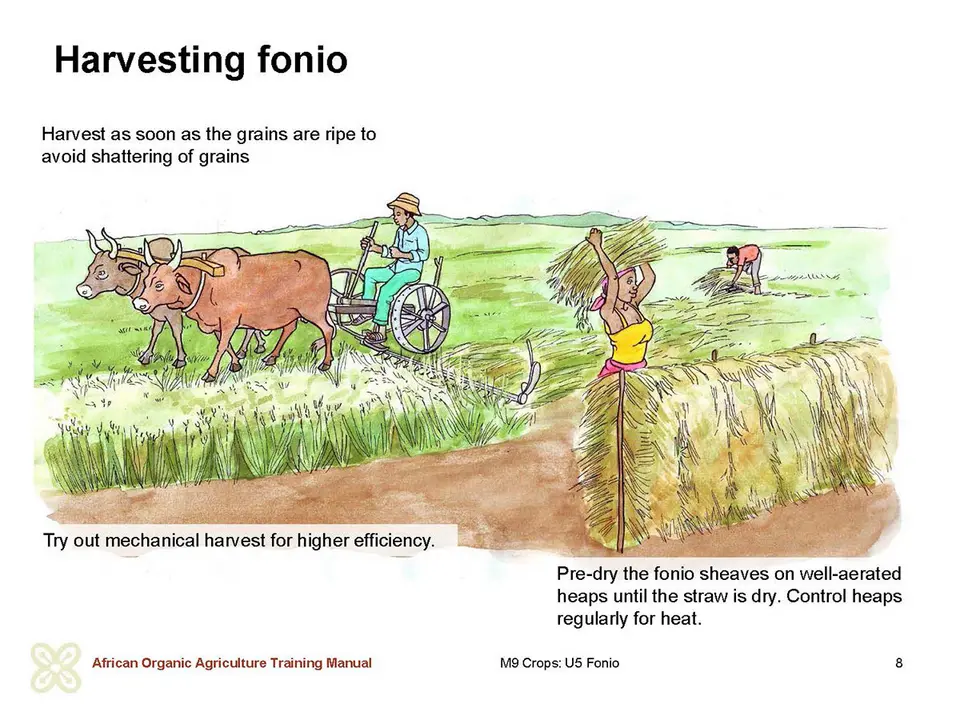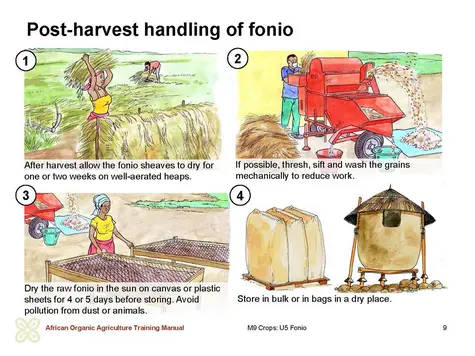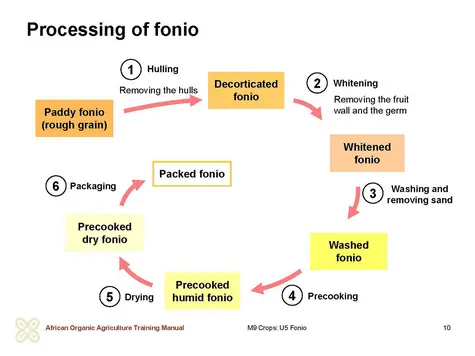Reducing harvest and post-harvest losses
Harvesting of fonio is often staggered to suit the immediate needs of the farmer’s family. But late harvesting can result in important grain losses due to birds, shattering and moulding. Manual harvesting is time consuming and the processing of fonio is lengthy and complex and subject to sand contamination and to heavy grain losses mainly due to the tiny size of the grains.
Many farmers abandoned fonio production because of the time consuming harvest and post-harvest processing. The efficiency of harvesting and processing determines to a great extent the profit a farmer makes. Measures to reduce grain losses include timely harvest, proper drying of the grains and application of improved methods of post-harvest handling. Measures to reduce labour costs include mechanised harvesting and post-harvest processing.
Harvesting
Fonio today is still all harvested by hand. This is done by cutting the dried plants with a knife or a sickle and gathering them into sheaves. Manual harvesting is very time consuming. Mechanisation of harvest could contribute to a more efficient harvest, but is challenged by lodging of fonio plants at harvest and limited cash of farmers.
To avoid major grain losses due to shattering before and during harvest the grains should be harvested as soon as they get ripe and before the dry season has fully established and air humidity has declined. At harvesting with the sickle the height of the cut varies depending on whether the straw is to be used as animal feed or not.
Grain yields of fonio commonly range from 200 kg per hectare on marginal land to 600 kg or more under good management.
Post-harvest handling
Pre-drying
After harvesting, the fonio sheaves are dried for about one or two weeks (or more), before being threshed. Well-dried straw is relevant for mechanical threshing. For drying, the sheaves are piled to round or oblong heaps on the edge of the field, built on simple wooden structures to improve aeration. In humid conditions such heaps may develop heat due to insufficient aeration and decomposition processes, or may encourage development of moulds. Both reduce the quality of the grains and can result in grain losses. Therefore, such heaps must be controlled regularly and must be disassembled as soon as they develop heat inside.
Threshing and sifting
Traditionally, threshing is done by hand, which is very laborious. Also, traditional threshing on non-paved soil results in high rates of sand contamination, whereas threshing on a paved surface is somewhat better. Threshing on a canvas is considered being best when threshing manually.
For mechanical threshing rice threshing machines were adapted to be used for fonio, processing 250 to 300 kg of grains per hour. Shifting from manual to mechanical processing can give farmers benefits, which are much higher than the investments. Mechanising the processing proves essential to reduce work and improve the quality and availability of marketed fonio. However, the relatively high costs to buy a threshing machine may be a constraint to some farmers. To reduce the costs, farmers should form groups to buy machines at village level, or threshing services should be provided to the farmers by the private sector.
Sifting of the grains after threshing removes part of the sand, which otherwise would wear down machines in further processing and would need to be removed for food production anyhow.
Drying
Threshed fonio, which is also called ‘fonio paddy’ or ‘raw fonio’, needs further drying for 4 to 5 days, as the hulls still remain on the grains. Fonio paddy is usually dried on traditional mats or on canvas or plastic sheets in the sun. The grains are sufficiently dry, when they run easily through the fingers (moisture content lower than 11 %).
Storage
Well-dried fonio grains store well and can be kept for many months or even years. They are not liable to damage by storage pests. For storage the grains are usually filled in bulk into traditional clay granaries. Or the product is stored in jute or in woven polypropylene bags for selling.
Hulling and whitening
The dried grains are further processed by removing the hulls from the grains (called hulling) and removing the fruit wall and the germ (called whitening). Hulling and whitening require 4 to 5 beatings with pestle and mortar, alternated with winnowing, when done by hand. For mechanical hulling and whitening the
GMBF (Guinea-Mali-Burkina-France)-huller was developed by CIRAD, with an output of about 100 kg of grains per hour.
After whitening, the fonio grains must be cleaned to remove the bran and foreign bodies such as sand. Cleaning is traditionally done by repeated washing, which is an extremely time-consuming and tedious operation.



 tap and then scroll down to the Add to Home Screen command.
tap and then scroll down to the Add to Home Screen command.